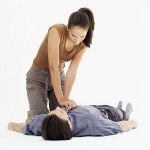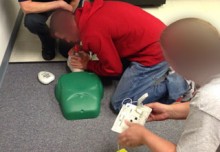First Aid Emergencies
Certainly first aid emergencies can happen anywhere. Home, school, work, church, shopping, sporting events, to name a few. Here we describe First Aid, who needs official first aid training and where your first aid plan should be recorded/documented.
A first aid program addresses the following: choking, cardiac arrest, treatment for bleeding, burns, sprains, broken bones, shock and other first aid emergencies. In addition, your first aid program must include how to perform CPR (Cardiopulmonary Resuscitation) and the use of an AED (Automated External Defibrillator).
Ask yourself, your family, your friends and your employees…
Do you know what to do if you came across a person in need?
Do you know who to call for additional help?
Can you determine if injury or illness is life threatening?
The answers to these questions should be a part of your Emergency Management Plan or Emergency Response Plan. If you need answers to these questions, this means you need to develop an emergency response plan and incorporate First Aid, CPR and AED Classes.
What is first aid? According to OSHA (Fundamentals of a Workplace First-Aid Program)
“First aid is emergency care provided for injury or sudden illness before emergency medical treatment is available. The first-aid provider in the workplace is someone who is trained in the delivery of initial medical emergency procedures, using a limited amount of equipment to perform a primary assessment and intervention while awaiting arrival of emergency medical service (EMS) personnel.”
On the job, are your first aid providers’ volunteer or is it a requirement of their jobs? The answer to this question determines the need for additional requirements of the Bloodborne Pathogen Standard (29 CFR 1910.1030).
Do you have a first aid program in the workplace? The OSHA First Aid standard (29 CFR 1910.151) requires trained first-aid providers at all workplaces of any size if there is no “infirmary, clinic, or hospital in near proximity to the workplace which is used for the treatment of all injured employees.” OSHA has long interpreted the term “near proximity” to mean that emergency care must be available within no more than 3-4 minutes from the workplace, an interpretation that has been upheld by the Occupational Safety and Health Review Commission and by federal courts. In addition to first-aid requirements of 29 CFR 1910.151, ***several OSHA standards including Confined Spaces, Electrical Power distribution, also require training in cardiopulmonary resuscitation (CPR) when your industry or specific workplace creates a higher risk of occurrences for cardiac arrest from asphyxiation, electrocution, or exertion.
By assessing the specific needs of your workplaces, you can determine what first aid supplies you will need. The supplies must be adequate, reflect the kinds of injuries that occur, and must be stored in an area where they are readily available for emergency access.
A specific example of the minimal contents of a workplace first aid kit is described in American National Standards Institute ANSI Z308.1 – 2009, Minimum Requirements for Workplace First Aid Kits.ANSI/SEA Z308.1 2009 – Minimum Requirements for Workplace First Aid Kits and Supplies Basic Kit – minimum contents.
|
The kits described are suitable for small groups and small businesses (50 people and under). For large operations, employers should determine how many first-aid kits are needed based upon your hazard/risk assessment and the number of employees. Approximately 1 First Aid Kit for every 50 employees. You will also need to determine if it is appropriate to augment the kits with additional first-aid equipment and supplies based upon your hazard/risk assessment findings. Click Here to link to CalOSHA’s Hazard/Risk Assessment worksheet. The following table summarizes the ANSI Z308.1 standard of recommended supplies.
|
Required Supplies |
Recommended Supplies |
|
Absorbent Compress |
Analgesic |
|
Adhesive Bandages |
Antibiotic Treatment |
|
Adhesive Tape |
Bandage Compress |
|
Antiseptic |
Breathing Barrier |
|
Burn Treatment |
Burn Dressing |
|
Medical Exam Gloves |
Cold Pack |
|
Sterile pad |
Eye Covering |
|
Triangular Bandage |
Eyewash |
|
Roller Bandage |
If you have questions about your First Aid Program or want to discuss how to develop a First Aid Program, contact us or call 773-313-3012. We can assess your current situation and recommend potential changes or additions, including help with Hazard and Risk assessments. We also offer both American Heart Association First Aid and CPR certification classes.
***several OSHA standards (referenced above)
The OSHA standards requiring CPR training are:
1910.146 Permit-required Confined Spaces
1910.266 Appendix B: Logging Operations – First-Aid and CPR Training
1910.269 Electric Power Generation, Transmission, and Distribution
1910.410 Qualifications of Dive Team
1926.950 Construction Subpart V, Power Transmission and Distribution












